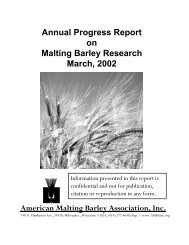Annual Progress Report on Malting Barley Research March, 2007
Annual Progress Report on Malting Barley Research March, 2007
Annual Progress Report on Malting Barley Research March, 2007
Create successful ePaper yourself
Turn your PDF publications into a flip-book with our unique Google optimized e-Paper software.
Spring Regi<strong>on</strong>al over two years at Davis and had near-malting quality. All of the parents<br />
in these three crosses have short stature. The two-rowed effort is more advanced than<br />
the six-rowed effort and the developmental pipeline is full of two-rowed material.<br />
The Oreg<strong>on</strong> St. Univ. six-rowed winter barley (STAB47/KAB51-20) was crossed into<br />
the winter by spring gene pool to create new populati<strong>on</strong>s. In July ‘06 winter by spring<br />
segregating populati<strong>on</strong>s in the F2 and F3 generati<strong>on</strong>s were sent to Pat Hayes for<br />
selecti<strong>on</strong> in a sec<strong>on</strong>d envir<strong>on</strong>ment. STUC 6 c<strong>on</strong>tinues to be the best six-rowed source<br />
of BYDV and stripe rust resistance combined with near-malting quality. Segregating<br />
populati<strong>on</strong>s of STUC 6 crossed to 6B96-9339, Drumm<strong>on</strong>d, and 94AB13449 are am<strong>on</strong>g<br />
the F3 bulks. The project has c<strong>on</strong>tinued to identify suitable malting barley parents and to<br />
create new populati<strong>on</strong>s. New crosses to be made in April ’07 will use Traditi<strong>on</strong>, Robust<br />
‘RWA’ (Russian Wheat Aphid resistant) lines developed by the USDA, and 01NZ706,<br />
which is ant643/WA9138-87//6B95-8253 supplied by Ditter v<strong>on</strong>Wetstein and the highest<br />
grain yielder in the Western Spring Regi<strong>on</strong>al barley trial grown at Davis in ‘06.<br />
Segregating populati<strong>on</strong>s of C<strong>on</strong>rad crossed to ICARDA/CIMMYT lines were planted<br />
as F3 bulks. Subsamples were sent previously to BARI for selecti<strong>on</strong> in a sec<strong>on</strong>d<br />
envir<strong>on</strong>ment . Orca and ND22202 crosses to Mexican materials are in the F2<br />
generati<strong>on</strong>. Madre Selva barley was used as a source of resistance to CYDV. Materials<br />
planted at Davis from other programs include the following: advanced lines from the<br />
cross BCD 47 to Bar<strong>on</strong>esse, BARI elite lines, and Tango X Lacey F3 lines. Twenty new<br />
crosses for malting quality were made in April ’06. Subsequently the F1’s were grown<br />
out at Ft. Collins by BuschAg. The harvested seeds were planted at Davis in Nov. ’06.<br />
Reserve F1 seeds were planted at Davis in Nov. ’06. New two-rowed parents likely to<br />
be used in crossing are Craft and 98AB11993, the latter of which was highly productive<br />
in the Western Spring Regi<strong>on</strong>al barley trial grown at Davis. The most time c<strong>on</strong>suming<br />
part of the project is given to selecti<strong>on</strong>, harvesting, seed processing and preparati<strong>on</strong> for<br />
planting subsequent generati<strong>on</strong>s in the germplasm pipeline.<br />
Most significant accomplishment<br />
The project has created its first malting advanced line germplasm worthy of distributi<strong>on</strong><br />
to other interested breeders (Table 1). Entries in bold type were created at UC Davis.<br />
Crosses involving Oreg<strong>on</strong> St. parents (described above) developed by Pat Hayes were<br />
made to a selecti<strong>on</strong> from the ICARDA/CIMMYT cross of TTA, which was originally<br />
planted at Davis in 1995 as a F2 populati<strong>on</strong> supplied by Hugo Vivar. The TTA<br />
populati<strong>on</strong> was selected for its absence of foliar diseases, short stature, and<br />
productivity. The TTA populati<strong>on</strong> and subsequent selecti<strong>on</strong>s were resistant to all<br />
diseases noted at Davis over several years during the selecti<strong>on</strong> process. BCD 47 like<br />
TTA appeared resistant to stripe rust, scald and net blotch but BCD 47 was susceptible<br />
to barley yellow dwarf virus and powdery mildew at Davis. Several lines from the TTA<br />
populati<strong>on</strong> were evaluated by CCRU and <strong>on</strong>e line was selected for crossing to BCD 47,<br />
BU, and SAL. Three lines (BCD/TTA-MQ29, BCD/TTA-N, and BCD/TTA-V) had CCRU<br />
quality scores above 60 compared to the highest CCRU Harringt<strong>on</strong> check quality value<br />
of 50. The lines having the MQ 28 and MQ29 designati<strong>on</strong> have two years of favorable<br />
7
















